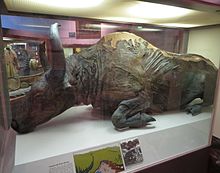Steppe bison
| Steppe bison | |
|---|---|

| |
| "Blue Babe", a mummified specimen from Alaska | |
| Scientific classification | |
| Domain: | Eukaryota |
| Kingdom: | Animalia |
| Phylum: | Chordata |
| Class: | Mammalia |
| Order: | Artiodactyla |
| Family: | Bovidae |
| Subfamily: | Bovinae |
| Genus: | Bison |
| Species: | †B. priscus
|
| Binomial name | |
| †Bison priscus | |
The steppe bison[Note 1] or steppe wisent (Bison priscus)[2] is an extinct species of bison. It was widely distributed across the mammoth steppe, ranging from Western Europe to eastern Beringia in North America during the Late Pleistocene.[3] It is ancestral to all North American bison, including ultimately modern American bison.[4][5] Three chronological subspecies, Bison priscus priscus, Bison priscus mediator, and Bison priscus gigas, have been suggested.[6]
Evolution
The steppe bison first appeared during the mid
Description
Resembling the modern bison species, especially the
Bison priscus gigas is the largest known bison of Eurasia. This subspecies was possibly analogous to Bison latifrons, attaining similar body sizes and horns which were up to 210 centimeters (83 in) apart, and presumably favored similar habitat conditions.[11]
The steppe bison was also anatomically similar to the
Extinction
The steppe bison distribution contracted to the north after the end of the
Discoveries

Steppe bison appear in
Blue Babe is the 36,000-year-old mummy of a male steppe bison which was discovered north of
In early September 2007, near Tsiigehtchic, local resident Shane Van Loon discovered a carcass of a steppe bison which was
In 2011, a 9,300-year-old mummy was found at Yukagir in Siberia.[24]
In 2016, a frozen tail was discovered in the north of the Republic of Sakha in Russia. The exact age was not clear, but tests showed it was not younger than 8,000 years old.[25][26] A team of Russian and South Korean scientists proposed extracting DNA from the specimen and cloning it in the future.[25][26]
The steppe wisent is known from Denisova Cave, famous for being the site where the first Denisovan remains were discovered.[27]
References
- ^ Several literatures address the species as primeval bison.
- ISSN 2199-2401.
- ^ a b "Steppe Bison" Archived 2010-12-12 at the Wayback Machine – Yukon Beringia Interpretive Centre. Beringia.com. Retrieved on 2013-05-31.
- ^ Hunting the Extinct Steppe Bison (Bison priscus) Mitochondrial Genome in the Trois-Frères Paleolithic Painted Cave
- ^ PMID 28289222.
- ^ .
- S2CID 132682791.
- S2CID 235527116.
- ISSN 0277-3791.
- ^ S2CID 133244037.
- ISBN 978-0306460920.
- ^ C. C. Flerow, 1977, Gigantic Bisons of Asia, Journal of the Palaeontological Society of India, Vol. 20, pp.77-80
- ^ a b c Markova, A. K., Puzachenko, A. Y., Van Kolfschoten, T., Kosintsev, P. A., Kuznetsova, T. V., Tikhonov, A. N., ... & Kuitems, M. (2015). Changes in the Eurasian distribution of the musk ox (Ovibos moschatus) and the extinct bison (Bison priscus) during the last 50 ka BP. Quaternary International, 378, 99-110.
- S2CID 54951935.
- S2CID 54951935.
- ^ Plasteeva, N. A., Gasilin, V. V., Devjashin, M. M., & Kosintsev, P. A. (2020). Holocene Distribution and Extinction of Ungulates in Northern Eurasia. Biology Bulletin, 47(8), 981-995.
- ISSN 2213-3054.
- ISSN 0277-3791.
- PMID 14739241.
- ISBN 9780226311234.
- JSTOR 20163935.
- ^ Deem, James M. "Blue Babe - the 36,000 year-old male bison"[permanent dead link] James M. Deem's Mummy Tombs. 1988-2012. Accessed 20 March 2012.
- ISBN 9780226311234.
- ^ ISSN 0277-3791.
- ^ Palermo, Elizabeth (6 November 2014). "9,000-Year-Old Bison Mummy Found Frozen in Time". www.livescience.com. Retrieved 4 December 2014.
- ^ a b "The remains of an 8,000 year old lunch: an extinct steppe bison's tail". siberiantimes.com. Retrieved 2021-03-09.
- ^ a b "Cloning ancient extinct bison sounds like sci-fi, but scientists hope to succeed within years". International Business Times UK. 2016-12-02. Retrieved 2021-03-09.
- . Retrieved 13 January 2024 – via Elsevier Science Direct.
